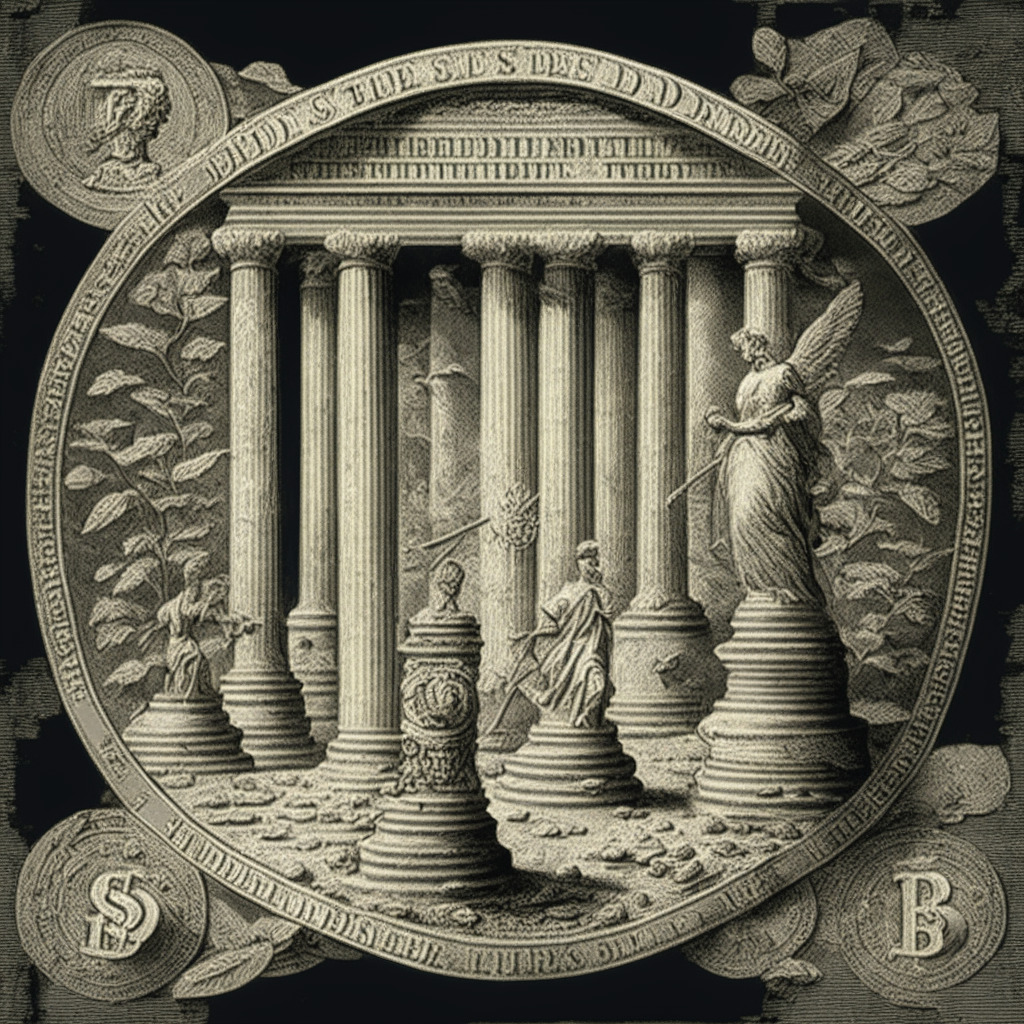The Canadian Securities Administrators’ recent clarification on stablecoin trading rules indicates that exchanges may be allowed to trade these value-referenced crypto assets if sufficient asset reserves are maintained and necessary information is disclosed. This regulatory intervention could significantly affect the crypto landscape in Canada.
Search Results for: stablecoins
Bankruptcy of Haru Invest: Impacts on Crypto Lending and The Future of Stablecoins
South Korean CeFi firm Haru Invest, recently filed for bankruptcy following fraud allegations. This incident affected fellow crypto lender, Delio, leading to a suspension of deposits and withdrawals in June. Despite bankruptcy, Haru set a phased asset recovery plan aiming to return investments equally to its users.
Stablecoins: Revolution in Progress or Ticking Time Bomb? Unraveling the Crypto Quandary
“In the world of digital assets, the role and impact of stablecoins is increasingly complex. Despite declining holdings in exchanges and concerns about their potential financial instability, Tether-based stablecoin loans have increased in 2023. The place of stablecoins in crypto markets presents an intricate web of contradictions and uncertainties.”
Stablecoins on Trial: Binance, Circle, and the Global Regulatory Showdown
The SEC has sued Binance for legal violations involving crypto tokens BNB and BUSD, and Circle argues that these stablecoins aren’t securities as their acquisition doesn’t foresee profit-making. Meanwhile, Gemini is closing its Netherlands operations for failing to meet regulatory requirements, highlighting growing tensions between crypto platforms and financial regulatory bodies.
Crypto Surge in Brazil: Rising Regulation, Dominance of Stablecoins, and Controversy over CBDC
Brazil, witnessing a 44.2% growth in cryptocurrency adoption between January and August 2023, expresses concerns on potential links to tax evasion. Banco Central do Brasil is intensifying regulation and planning its own central bank digital currency (CBDC), raising discussions on digital financial safety.
Unraveling Stablecoins: Booming Assets or Impending Crisis?
“This report by the United States Federal Reserve Banks reveals the potential impact of stablecoins on the economy. Highlighting the similarity between stablecoins and money market funds, it warns of the vulnerabilities these coins face during market downturns. Issues like risky backing collateral and erosion of investor confidence can lead to substantial losses.”
Federal Reserve Concerns: Stablecoins’ Instability or the Next Financial Evolution?
“Federal Reserve Banks express concern that stablecoins could introduce instability into the financial system due to lack of standard regulatory framework. The Central Bank of Italy reinforces stablecoins’ unstability and presses for international regulatory body to govern cryptocurrencies. Despite risks, blockchain-based cross-border payments show promise of cost-effective solutions.”
Pushing Boundaries: Binance’s Plan for Stablecoins Expansion in Japan
“Binance plans to launch stablecoins pegged to the dollar, euro, and yen in partnership with Mitsubishi UFJ Financial Group in Japan. Leveraging MUFG’s blockchain platform, this initiative aims to launch in 2022, expanding existing crypto trading and payment services. Future offerings could also be introduced subject to regulatory approvals.”
Declining Dominance of Stablecoins: A Shift Towards Traditional Assets or a Chance for Recovery?
Despite a difficult year, the focus stays on the declining stablecoin sector, with major stablecoins like USDT showing consistent growth amidst the downturn. Factors such as legal action against major crypto exchanges and swings in stablecoin trading volumes due to the rush to list Bitcoin ETFs have impacted this fall. However, PayPal’s recent introduction of PYUSD could revive confidence in the sector. The future of stablecoins, while currently unstable, is still pivotal to the crypto landscape.
The Dwindling Dominance of Stablecoins: A Market Shift Towards Traditional Assets
Stablecoin market dominance has declined to 11.6%, despite a 10.9% rise in trading volume for such currencies. Despite challenges faced by cryptocurrencies, the launch of PayPal’s stablecoin PYUSD might revive investor faith in stablecoins, and encourage broader crypto adoption.
Navigating the Storm: EU’s MiCA and the Future of Stablecoins in Europe
“The European Union’s upcoming Markets in Crypto Assets (MiCA) regulation has raised concerns about the potential delisting of all stablecoins in Europe by June 30. MiCA aims to streamline processes and enhance oversight. However, its provisions concerning stablecoins are causing apprehension, especially as they seem to contradict the aspirations of many issuers for decentralization.”
Binance’s Plan to Delist Stablecoins in Europe: A Critical Look at Regulatory Compliance and Market Impact
“Binance, a key cryptocurrency exchange, plans to delist all stablecoins for the European market by June 2024, in adherence to the Markets in Crypto Assets (MiCA) law. This move, expected to impact significantly on Europe’s market, reflects the potential disruptions regulatory changes can cause. Meanwhile, the U.S. resists implementing a Central Bank Digital Currency (CBDC), despite other countries’ pursuits of national digital currency.”
Decentralized Stablecoins: The Future Star or Centralization Roadblock of the Crypto Market?
Rune Christensen, co-founder of DeFi pioneer MakerDAO, foresees decentralized stablecoins dominating the crypto market while centralized ones may have the function of connectors with the traditional financial system. In the rapidly changing cryptocurrency landscape, regulation-friendly procedures and addressing centralization issues are critical in leveraging the potential of decentralized stablecoins.
Foreseeing a Bitcoin Crash: Comparing Cryptocurrency Trends and Future Stability with Stablecoins
“An ominous Bitcoin price metric that previously resulted in a -25% FTX crash is repeating, centred around the BTC rate of $25,726. Market spectators prepare for a possible drop to $23,000. The Short to Long-Term Realized Value (SLRV) ratio indicates potential sales growth in ‘older’ Bitcoins, urging caution among investors. Meanwhile, stablecoin Circle’s USD Coin (USDC) now supports smooth transitions to Base and Optimism networks.”
Stablecoins: The Potential Game-Changer in Global Financial Services and Their Associated Risks
“The rapid growth of digital currency market showcases colossal potential of stablecoins, with Brevan Howard Digital predicting their scale to reach several trillions. Stablecoins could financially assist the unbanked and underbanked, provide an economic safe haven, and even challenge global financial services.”
BTC Price Defies Predictions; Stability Amid Market Volatility & Future of Stablecoins
“As BTC price holds steady on a 200-day trend line, traders see this as a potential market low. Despite BTC retracting from highs, it hasn’t experienced a total reversal. Other developments in the crypto market, such as Binance’s plans to cease support for its BUSD stablecoin, influence this complex, evolving landscape.”
Coinbase Acquires Stake in Circle: Betting Big on Stablecoins and Shaping Cryptocurrency Markets
Coinbase has acquired a minority stake in Circle Internet Financial and both companies dissolved their Centre Consortium associated with issuing USD Coin (USDC). Amid greater regulatory clarity, Circle will become the sole issuer of USDC and control reserve governance, facilitating its integration on various blockchains. This shifting control indicates wider stablecoin adoption in the crypto economy.
Coinbase Halts Trading of Stablecoins Amid Tough Crypto Regulations in Canada
Coinbase, a major cryptocurrency exchange, announces the suspension of trading for three popular stablecoins in Canada starting from August 31. Despite the trading halt, the wallets will still be functional for deposits and withdrawals. However, Canada’s stern stance towards crypto service providers and stringent regulations have led to many crypto exchanges, including Binance and OKEx, pulling out from the Canadian market.
Tether Discontinues Bitcoin, Kusama and Bitcoin Cash-Based Stablecoins: Impact on Crypto Landscape
“Tether, the issuer of popular stablecoin USDT, discontinues its Bitcoin, Kusama, and Bitcoin Cash-based stablecoins due to low usage. It reflects Omni’s crucial role and considers reinstating Omni Layer version if utility increases. Also, Tether plans to introduce a new Bitcoin-based smart contract system, “RGB”.”
Canada’s Crypto Conundrum: The Fate of Stablecoins Amidst Surging Regulations
“Crypto exchange Coinbase is set to suspend trading of stablecoins USDT, DAI, and RAI in Canada as part of major service changes. Despite Coinbase’s recent expansion in Canada, increasing regulations have caused reconsideration of operating strategies within the country’s crypto market.”
Regulatory Ripples: The SEC’s Case against Ripple and the Future of Stablecoins in Canada
“Judge Torres’s ruling in the ongoing Ripple case might bring regulatory clarity to the crypto community. Meanwhile, Coinbase suspended certain stablecoins in Canada, raising questions on whether this regulatory rigour might affect the growth of blockchain’s future or secure the crypto future.”
New Regulatory Landscape for Stablecoins: Balancing Investor Protection with Innovation
The Monetary Authority of Singapore (MAS) has unveiled a regulatory framework for stablecoins, providing guidelines for issuers on value stability, capital, and redemption. This move, which could bring security while potentially stifling small-scale startups, reflects a global trend in digital currency regulation.
Regulating the Future: Implications of Singapore’s Revised Framework for Stablecoins
Singapore’s central bank, the Monetary Authority of Singapore (MAS), introduced a revised regulatory framework for single-currency stablecoins (SCS). The new guidelines aim to guarantee stability for SCS pegged to major currencies, potentially bolstering the use of stablecoins as a trusted digital medium of exchange.
Stablecoins in Turmoil and the Rise of $WSM: The Game-Changing Token of 2023
“Major tremors are rocking the DEX markets with ZKSync DEX stablecoin USD+ undergoing tumultuous highs and lows, sparking extraordinary price fluctuations. Amid the turbulence, the Wall Street Memes token ($WSM) has garnered interest, amassing +$23.7m in its presale funding.”
PayPal’s PYUSD vs Major Stablecoins: A Battle for Market Share or a Losing Game?
“Bank of America suggests PayPal’s stablecoin, PYUSD, may struggle in the face of established competitors like USD Tether (USDT) and USD Coin (USDC). Factors such as lack of fresh functionality and wallet compatibility issues could impede its progress. However, PYUSD has potential to enhance customer experience within the PayPal ecosystem and capitalize on blockchain-enabled asset transfers, payments, and remittance services.”
Unleashing Stablecoins: Assessing PayPal’s PYUSD Launch Amid Political Divides and Regulatory Turbulence
“PayPal’s recent launch of its stablecoin, PYUSD, under the regulatory framework of the New York Department of Financial Services has stirred conversations about stablecoin adoption. Unlike Meta’s unsuccessful Libra, PayPal’s project is viewed more favorably politically, indicating an imminent regulatory framework for stablecoins in the U.S.”
Crypto Regulations Tighten: Mashinsky’s Trial and the Controversial Role of Stablecoins
Former Celsius CEO, Alex Mashinsky, is restricted in his financial operations and movement due to charges related to cryptocurrency fraud. Meanwhile, stablecoins are being discussed as a way to ensure US dollar’s global dominance, while critics warn of potential instability. The crypto and blockchain world continues to struggle for legitimacy and stability.
Stablecoins: The Potential Lifeline for US Dollar’s Global Dominance and The Challenge of Regulation
Stablecoins could potentially retain the global dominance of the U.S. dollar, countering “de-dollarization”. The authors express that with proper regulatory frameworks, stablecoins could reestablish the U.S. dollar’s role in international trade and provide relief for hyperinflation-affected economies.
Inflation Data Impact on Crypto Markets: Stablecoins as a Stabilizer vs Small Cap Coin Volatility
“The cryptosphere is experiencing market anxiety due to the U.S Consumer Price Index inflation data, impacting market dynamics significantly. While Bitcoin and Ethereum display positive trading bias, failure to surpass resistance levels evidences concern. Market stabilization is being supported by optimism around Paypal’s stablecoin, which could simplify fiat to crypto exchange.”
Regulatory Revolution: Bank of England’s Approach to Systemic Stablecoins and its Potential Impact
The “Payments Regulation and the Systemic Perimeter” framework introduced by the Bank of England specifies regulations for systemic stablecoins. The framework outlines collaboration among multiple regulatory bodies, with the Bank of England holding veto power over potential actions against important institutions. The goal is to enable safe adoption of crypto and establish a well-regulated future for systemic stablecoins.
Unveiling Paxos Trust’s Future Vision: New Projects, Stablecoins, and a Blockchain Powered Economy
Crypto infrastructure provider, Paxos Trust, prepares for advancements in stablecoin operations, according to Head of Strategy, Walter Hessert. Projects mirror PayPal’s PYUSD, broadening its applicability from consumer payments to cross-border transactions, aiming for blockchain mass adoption.
Stablecoins in the UK: Balance between Consumer Protection and Systemic Stability
“The future of UK’s stablecoins appears secure following the Bank of England’s intent to establish a systemic stablecoin regime, jointly overseen by the BoE and the Financial Conduct Authority. Recent developments include an extended accountability framework and considerations towards insolvency cases. However, concerns surround potentially favouring the return of customer funds over service continuity.”































